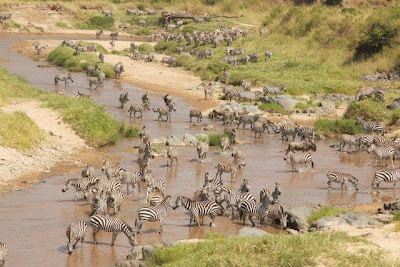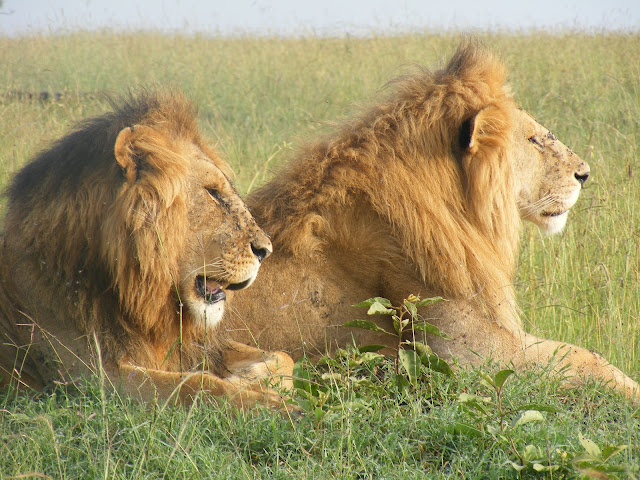It’s cloudy with cold showers late in the evening. The grass is moist and relished by the elephants and buffaloes. The Masai blankets are indispensable on the morning game drives. The impala males are rutting; the elephant females are in estrous and the hippos are mowing the grass along the Olare Orok River. It’s a very active season in the Mara.
WILDEBEEST MIGRATION
The long awaited migration of the wildebeest is on. The plains are rich with zebras, gazelles and many species of birds. There are endless lines of the wildebeest streaming to the Sand River to cross into the Mara game reserve from the bordering Serengeti in Tanzania. Without wasting time around the river, the wildebeest spread in the tall green red oat grass. According to the grazing succession, thousands of zebras lead the way.
They then branch into two groups. One goes up north and the other group moves west towards the Mara River, by the Lookout hill, which is 18 kilometers south of Mara Intrepids Camp.
We hope to see the first crossing at this point in two or three days. There are small groups at Posse and Olkiombo Plains but they look confused as to which way to proceed. The lions and hyenas are having a good time hunting them.
The Loita Plain migration is pressing in from the north towards the Olkiombo Plain.
PREDATORS SIGHTINGS
Lions
The prides have started to group
and position themselves at their favorite strategic points along the rivers
where the migration crosses. They are very alert, hiding in the tall grass.
Notch’s boys have not been
seen for almost a week. Notch is busy with the four lionesses from the Olkiombo
Pride near Maji ya Fisi.


The Olkeju Ronkai pride has
moved further south towards Lookout Hill. They could be waiting for the
migration or pushed out by the Ridge Pride.

The Ridge Pride has moved to
the south of Mara Intrepids Camp to await the wildebeest.
Leopards
After Olive killed the water
buck in front of Mara Explorer Camp, she has gone to her hideout area. She will
re-emerge when hungry again. She was last spotted by Smelly Crossing, west of
the Olkiombo airstrip with her cub.
Another friendly leopard at Shamarta
was seen once with an impala kill in a tree and another time looking very
relaxed with a Thomson gazelle.
Cheetahs
Malaika (seen above with with her two cubs recently) is around Olkiombo Plain near Mara Intrepids Camp. Unfortunately she has lost one cub to the hyenas and remains with just one.
Heritage Hotels (Kenya) manages two luxury camps in the Masai Mara - Mara Explorer and Mara Intrepids - in the confluence of the four game viewing areas of the Masai Mara. The camps are on the banks of the Talek River, with most tents spread along the banks. Report and pictures by John Parmasau, Mara Explorer & Mara Intrepids Camp ©Heritage Hotels Ltd, Kenya. http://www.heritage-eastafrica.com/










































